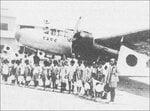islandee
Airman
From Masao Seto's autobiography, Life Story (p 92), photos of two aircraft at Don Muang Airstrip, Bangkok, Thailand, 1939 --- see attachments. The aircraft are not identified in the text. Can anyone identify them?
I thank you.
Hak Hakanson
Chiang Mai
I thank you.
Hak Hakanson
Chiang Mai


